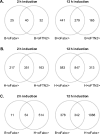RNA-seq reveals multifaceted gene expression response to Fab production in Escherichia coli fed-batch processes with particular focus on ribosome stalling
- PMID: 38183013
- PMCID: PMC10768439
- DOI: 10.1186/s12934-023-02278-w
RNA-seq reveals multifaceted gene expression response to Fab production in Escherichia coli fed-batch processes with particular focus on ribosome stalling
Abstract
Background: Escherichia coli is a cost-effective expression system for production of antibody fragments like Fabs. Various yield improvement strategies have been applied, however, Fabs remain challenging to produce. This study aimed to characterize the gene expression response of commonly used E. coli strains BL21(DE3) and HMS174(DE3) to periplasmic Fab expression using RNA sequencing (RNA-seq). Two Fabs, Fabx and FTN2, fused to a post-translational translocation signal sequence, were produced in carbon-limited fed-batch cultivations.
Results: Production of Fabx impeded cell growth substantially stronger than FTN2 and yields of both Fabs differed considerably. The most noticeable, common changes in Fab-producing cells suggested by our RNA-seq data concern the cell envelope. The Cpx and Psp stress responses, both connected to inner membrane integrity, were activated, presumably by recombinant protein aggregation and impairment of the Sec translocon. The data additionally suggest changes in lipopolysaccharide synthesis, adjustment of membrane permeability, and peptidoglycan maturation and remodeling. Moreover, all Fab-producing strains showed depletion of Mg2+, indicated by activation of the PhoQP two-component signal transduction system during the early stage and sulfur and phosphate starvation during the later stage of the process. Furthermore, our data revealed ribosome stalling, caused by the Fabx amino acid sequence, as a contributor to low Fabx yields. Increased Fabx yields were obtained by a site-specific amino acid exchange replacing the stalling sequence. Contrary to expectations, cell growth was not impacted by presence or removal of the stalling sequence. Considering ribosome rescue is a conserved mechanism, the substantial differences observed in gene expression between BL21(DE3) and HMS174(DE3) in response to ribosome stalling on the recombinant mRNA were surprising.
Conclusions: Through characterization of the gene expression response to Fab production under industrially relevant cultivation conditions, we identified potential cell engineering targets. Thereby, we hope to enable rational approaches to improve cell fitness and Fab yields. Furthermore, we highlight ribosome stalling caused by the amino acid sequence of the recombinant protein as a possible challenge during recombinant protein production.
Keywords: Envelope stress; Periplasmic expression; Polyproline; Recombinant protein production; Ribosome stalling; Transcriptomics.
© 2024. The Author(s).
Conflict of interest statement
The authors declare no competing financial interests.
Figures





Similar articles
-
Evaluation of three industrial Escherichia coli strains in fed-batch cultivations during high-level SOD protein production.Microb Cell Fact. 2013 Jun 11;12:58. doi: 10.1186/1475-2859-12-58. Microb Cell Fact. 2013. PMID: 23758670 Free PMC article.
-
Strain specific properties of Escherichia coli can prevent non-canonical amino acid misincorporation caused by scale-related process heterogeneities.Microb Cell Fact. 2022 Aug 23;21(1):170. doi: 10.1186/s12934-022-01895-1. Microb Cell Fact. 2022. PMID: 35999607 Free PMC article.
-
E. coli HMS174(DE3) is a sustainable alternative to BL21(DE3).Microb Cell Fact. 2018 Oct 30;17(1):169. doi: 10.1186/s12934-018-1016-6. Microb Cell Fact. 2018. PMID: 30376846 Free PMC article.
-
Full-length recombinant antibodies from Escherichia coli: production, characterization, effector function (Fc) engineering, and clinical evaluation.MAbs. 2022 Jan-Dec;14(1):2111748. doi: 10.1080/19420862.2022.2111748. MAbs. 2022. PMID: 36018829 Free PMC article. Review.
-
Over-production of proteins in Escherichia coli: mutant hosts that allow synthesis of some membrane proteins and globular proteins at high levels.J Mol Biol. 1996 Jul 19;260(3):289-98. doi: 10.1006/jmbi.1996.0399. J Mol Biol. 1996. PMID: 8757792 Review.
Cited by
-
Biosensor that Detects Stress Caused by Periplasmic Proteins.ACS Synth Biol. 2024 May 17;13(5):1477-1491. doi: 10.1021/acssynbio.3c00720. Epub 2024 Apr 27. ACS Synth Biol. 2024. PMID: 38676700 Free PMC article.
-
Recent advances in recombinant production of soluble proteins in E. coli.Microb Cell Fact. 2025 Jan 16;24(1):21. doi: 10.1186/s12934-025-02646-8. Microb Cell Fact. 2025. PMID: 39815265 Free PMC article. Review.
References
MeSH terms
Substances
LinkOut - more resources
Full Text Sources
Miscellaneous

